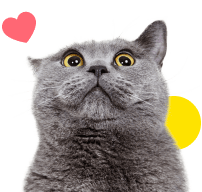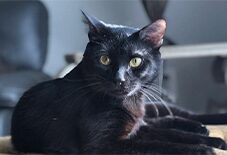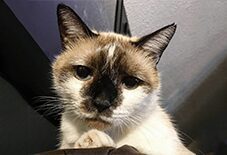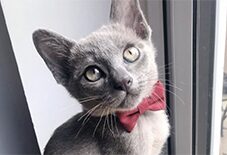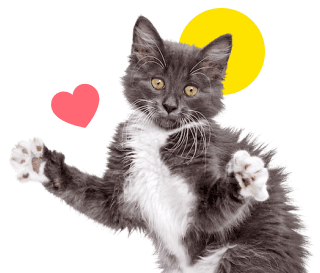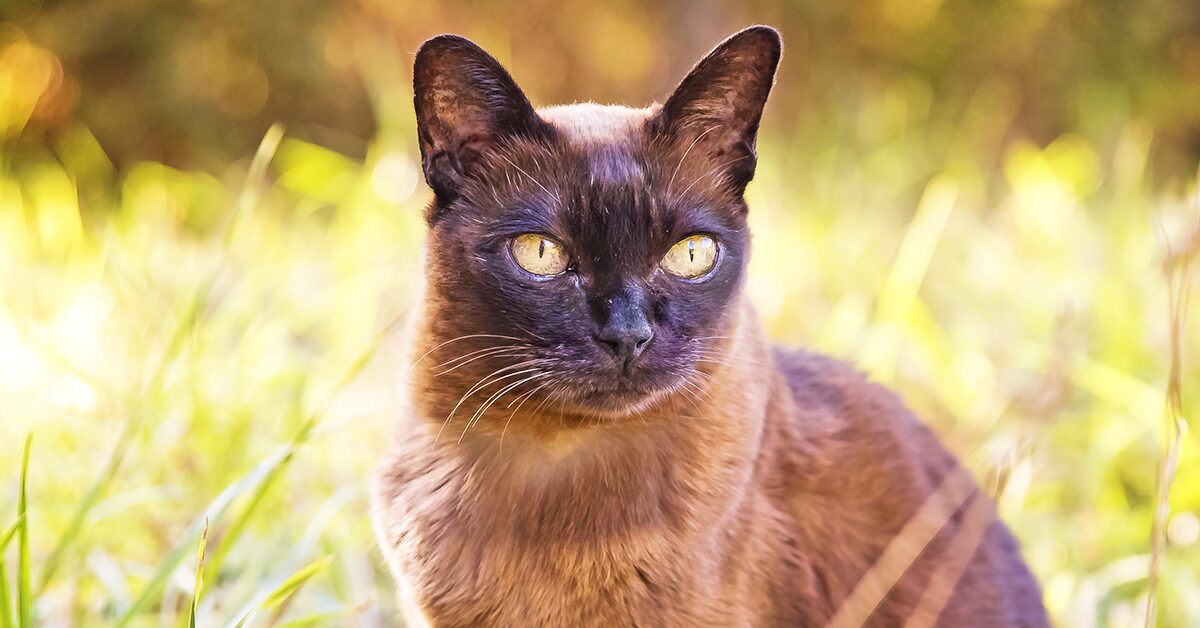
Meet the Burmese
Best Fur Friend
High Kitty I.Q.
Low-Maintenance Looks
If you’re looking for the prrrfect companion for the whole family, I’m the breed for you! We Burmese are known for being one of the friendliest cat breeds around, and I’m great with kids and cat-friendly pets. I form very strong bonds with my family so I don’t do well left alone for too long. The humans say I have a dog-like personality because I’m outgoing, playful, and have big expressive eyes. I’m also a chatterbox, but I have a sweet soft meow, not a loud bark!
I’m athletic and inquisitive so make sure you get me puzzle toys and a cat tree so I can practice my high jump (though I’ll probably end up on your shoulders half the time). As long as I get my energy out, I’m happy to snuggle up and chill in your lap. I’m one of the prettiest kitties around, but lucky for you I only need a weekly brushing to keep me looking furbulous. Between our low-maintenance looks and charming personalities, it’s no wonder that humans love us as much as we love them!
Ready to learn more about me? Let’s dig in.
Ready to learn more about me? Let’s dig in.
 My Many Looks
My Many Looks
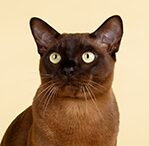
Sable
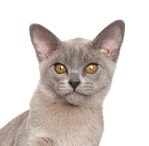
Lilac
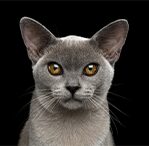
Blue
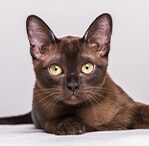
Brown Tortoiseshell
 My Breed Characteristics
My Breed Characteristics
 Furbulous Fact
Furbulous Fact
There are actually 2 kinds of Burmese cats – the American Burmese and the European Burmese! We have the same pawesome personality but we look a bit different. The American Burmese comes in 4 solid colors (sable, platinum, champagne, and blue) while the European Burmese comes in lots of different colors and also a tortoiseshell pattern. Americans also have a more rounded head and compact body than Europeans. Many cat registries don’t differentiate between us, but the CFA considers us separate breeds.
 As I Grow Up
As I Grow Up
As you can see, we Burmese age pretty gracefully. Here are a few key milestones in my growth & development to be aware of as I grow up from a kitten to an adult and senior!
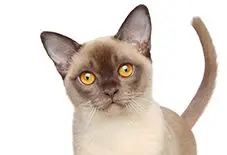
Kitten3-9 Months
Get me used to teeth brushing early on – I’ll love the attention, and treats always help!
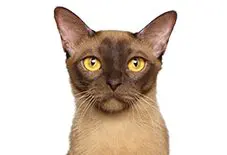
Adult1 Year
I’m a smart active breed and I love to play and climb. Make sure I have lots of puzzle toys and a cat tree to keep me occupied.
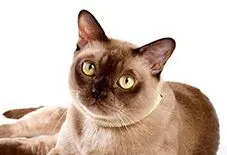
Senior10-11 Years
I’m slowing down a bit so make sure to adjust my cat food to a senior-friendly formula so I don’t get too chunky!
 History of My Breed
History of My Breed
My breed as we are today can all be traced back to one ancestor – a cat named Wong Mau. Wong Mau was a walnut-brown female with dark brown points and came from Burma (which is called Myanmar today). In 1930, a sailor brought Wong Mau to the United States and she was given to Dr. Joseph Thompson. Dr. Thompson was a Siamese cat breeder from San Francisco, and he decided to breed Wong Mau with a seal point Siamese named Tai Mau in order to figure out exactly what breed Wong Mau was. The litter resulted in some kittens that looked more Siamese and some that were brown with dark brown points like Wong Mau. This led Dr. Thompson to believe that Wong Mau was a hybrid of a Siamese and a native cat of Burma. He then bred Wong Mau with one of her brown kittens and produced a litter that included dark brown kittens (the color the humans call sable today) and those were the kittens that the Burmese breeding program was based on.
The Cat Fanciers’ Association first recognized us in 1936 but they weren’t happy that many humans were crossbreeding us with Siamese cats to increase our numbers. They took away our purebred status in 1947 and they meant business, so Burmese breeders had to be very strict with their breeding programs in order to get us back in the show ring. Finally, in 1957, the CFA let us back in and by the 1970s we were the third most popular breed in America (behind the Persian and the Siamese). Many different breeds come from the Burmese, including the Bombay, Burmilla, and Tonkinese. Interestingly enough, the Tonkinese (which was recognized by the CFA in 1984) is a Siamese/Burmese cross – the exact thing they kicked us out for – and my ancestor Wong Mau was also a Siamese/Burmese-type mix!
 Pawesome Cats to Parent
Pawesome Cats to Parent
In addition to purebred Burmese like me, there are tons of prrrfectly sweet mixed-breed Burmese that are looking to find their furever homes. You can learn where to find your next pet below!
 Care Tips
from Dr. Corinne Wigfall, Veterinarian
Care Tips
from Dr. Corinne Wigfall, Veterinarian 
Monitor your Burmese’s weight.
Burmese are prone to weight gain. This can lead to osteoarthritis and other weight-related issues. It’s important to weigh your Burmese every 3-6 months and get your veterinarian to perform a body condition score. Weight loss can be a challenge, so early intervention with an appropriate weight loss diet and exercise is recommended.
Watch your Burmese for any signs of diabetes.
Burmese cats are predisposed to diabetes. Signs include weight loss, increased thirst, increased urination, and lethargy. If not treated, this disease can progress to diabetic ketoacidosis, which has the potential to be life threatening. Diabetes can be well controlled in cats with injectable medications or diet, and some can even go into remission.
Grooming is a good time to check for other issues.
The Burmese’s coat is easy to manage and requires only a gentle brush once weekly. This is a good opportunity to bond with your Burmese whilst also being able to check their ears, skin, feet, and belly for any signs of illness. If during the groom your cat cries out in pain or moves away, this could be a sign of pain or internal injury.

 Why Get Cat Insurance?
from Pumpkin®
Why Get Cat Insurance?
from Pumpkin®
While Burmese are a generally healthy breed, cat-astrophes can happen to any cat at any age. If your kitty gets hurt or sick, pet insurance can help you say ‘yes’ to the best care, even when it’s costly. When it comes to shopping for this breed, you’ll want to choose insurance plans like Pumpkin's, which can help cover the costs associated with the hereditary conditions Burmese are prone to developing. While a reputable breeder will conduct genetic testing on your kitty’s parents to help minimize the chances of passing down hereditary conditions, they can’t always be avoided. Let’s look at some common ones, and how Pumpkin Insurance could help cover the cost of care!
 Bladder Stones
Bladder Stones
Burmese are prone to developing bladder stones. This condition occurs when minerals build up and form stones that make urination extremely painful to impossible, depending on their size. While smaller stones can be removed via catheter, larger stones must be surgically removed.
- Cost to Treat
- $500-$3,500
- Pumpkin Pays Back*
- $450-$3,150
 Diabetes Mellitus
Diabetes Mellitus
Cats with diabetes do not produce enough insulin to convert the glucose (sugar) in their blood into cellular energy. This can cause excessive urination, weight loss, and can lead to various infections. Diabetes can be managed with diet change, weight loss, and insulin injections.
- Cost to Treat
- $500-$5,000
- Pumpkin Pays Back*
- $450-$4,500
 Periodontal Disease
Periodontal Disease
Periodontal (gum) disease occurs when plaque builds up, forming a layer of tartar that inflames the gums. Left untreated, gums weaken and separate from teeth. While routine brushing, cleanings, and antibiotic gels help treat milder cases, severe ones require surgery.
- Cost to Treat
- $400-$1,200
- Pumpkin Pays Back*
- $360-$1,080
 Hypokalemic Polymyopathy
Hypokalemic Polymyopathy
Burmese cats are genetically predisposed to this condition, in which low potassium levels in the blood cause muscle weakness and limited mobility. While there is no cure, cats with this condition can be treated with potassium supplements and veterinarian-administered IV treatments to control potassium levels.
- Cost to Treat
- $500 to $3,000
- Pumpkin Pays Back*
- $450-$2,700
*Example illustrates reimbursement of a covered vet bill at a 90% reimbursement rate, where the annual deductible had already been satisfied and the annual limit had not yet been met. Coverage and reimbursement results vary based on policy options.
